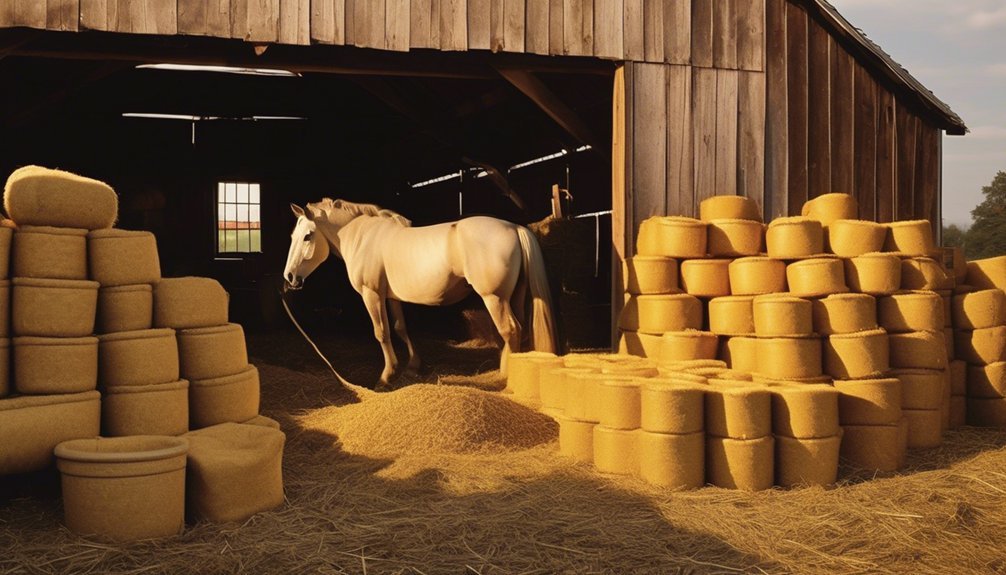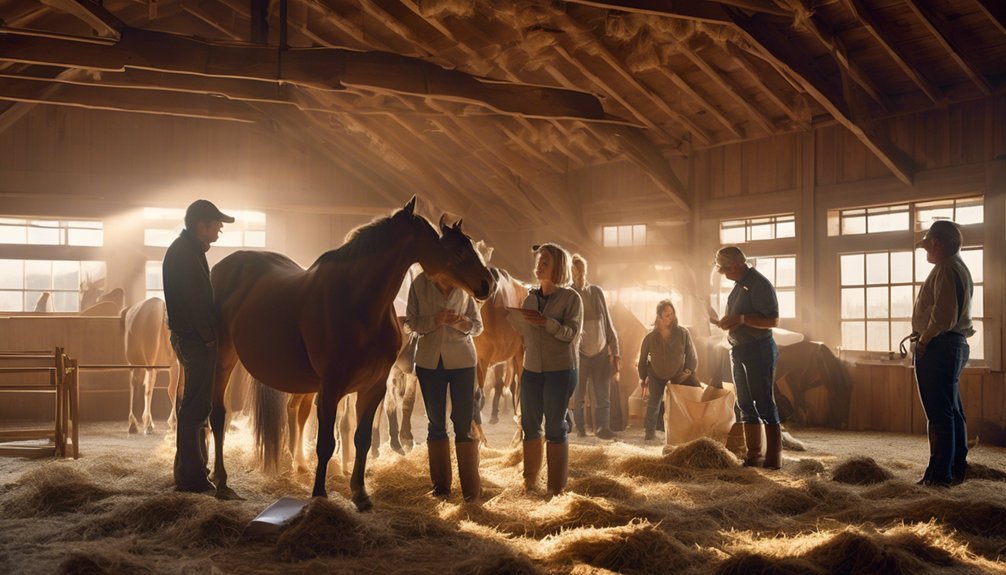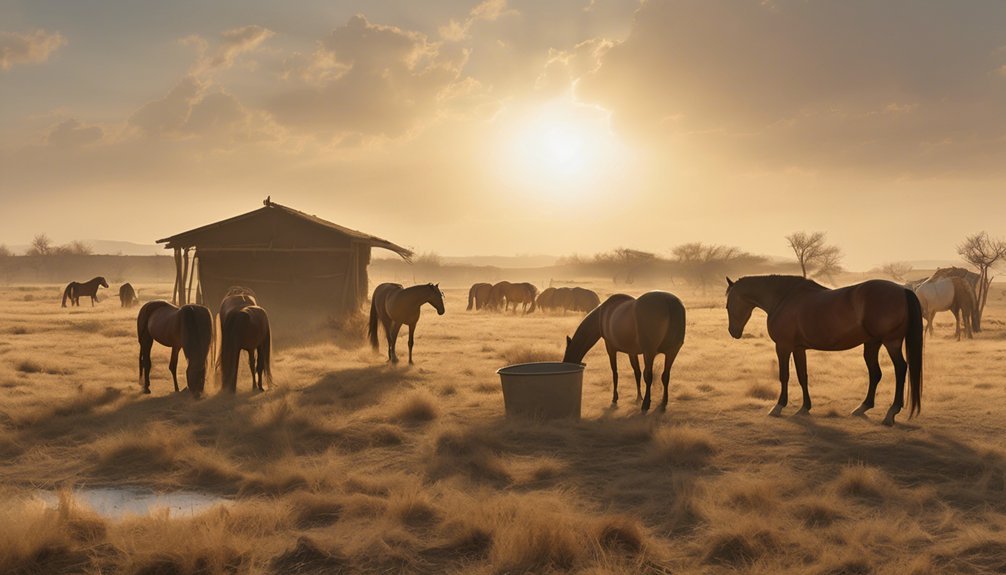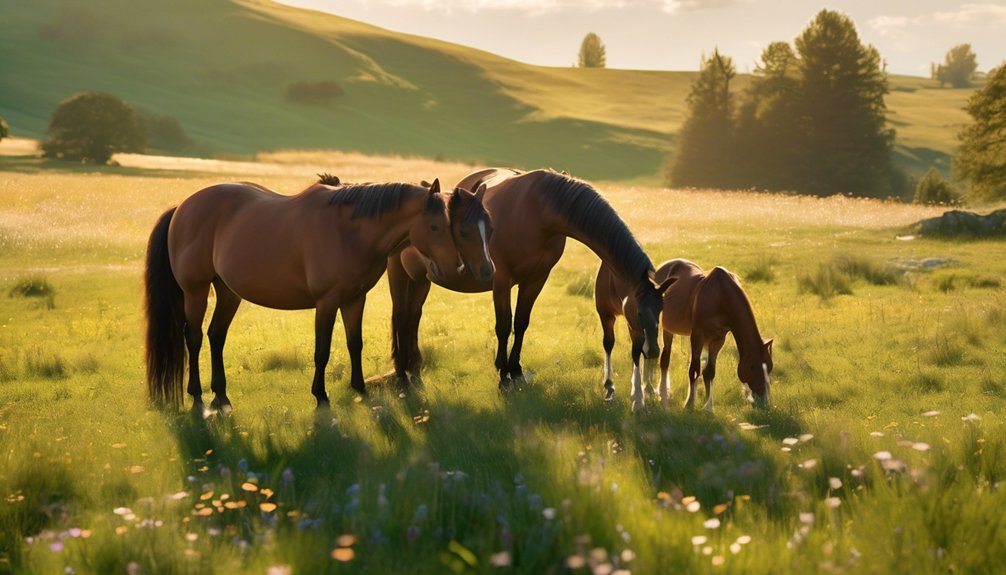
When faced with a feed shortage, it's crucial to understand your horse's nutritional needs and how to adjust their diet accordingly. Assessing available feed resources and exploring alternative options can make a significant difference. Implementing strategies that prioritize forage and supplementing with essential nutrients are key. However, managing these changes requires careful monitoring and planning. How do you ensure your horse remains healthy and nourished during this challenging time? Let's explore effective solutions together.
Key Takeaways
- Assess current feed inventory to determine available resources and identify shortfalls in essential nutrients.
- Prioritize high-quality forage, such as hay or pasture, to meet basic fiber and energy needs during shortages.
- Explore alternative feed options like beet pulp, hay cubes, or forage supplements to provide additional nutrients.
- Gradually introduce any new forages or feeds to avoid digestive issues and ensure horse adaptation.
- Monitor horse's health and body condition closely, adjusting feeding strategies as necessary to prevent deficiencies.
Understanding Your Horse's Nutritional Needs

When you understand your horse's nutritional needs, you can ensure they remain healthy and energetic, even in emergencies. Achieving a proper nutritional balance is crucial, as it affects your horse's overall well-being.
Start by assessing their energy requirements based on factors like age, weight, and activity level. A mature horse in light work generally needs around 1.5-2% of their body weight in forage daily. Make sure to include quality hay or pasture, which provides essential fiber.
Additionally, consider incorporating grains or concentrates for added energy, especially if your horse needs to maintain weight. Regularly evaluate their body condition to adjust feeding strategies, ensuring they receive the right nutrients to thrive—even when resources are limited.
Assessing Available Feed Resources
How can you effectively assess the feed resources available for your horse in an emergency? Start by conducting a thorough feed inventory to identify what you have on hand. This includes hay, grains, and any supplements. Next, perform a resource evaluation to determine the quality and quantity of each item.
Here's a simple table to help you organize your findings:
| Feed Type | Quantity Available |
|---|---|
| Hay | |
| Grain | |
| Pellets | |
| Supplements | |
| Other |
Exploring Alternative Feed Options

After assessing your available feed resources, it's important to explore alternative feed options that can sustain your horse during emergencies.
Alternative grains, such as oats, barley, and corn, can provide essential energy when traditional feeds are scarce. However, always ensure these grains are fed in moderation to prevent digestive issues.
Additionally, consider diverse forage types, like hay cubes or beet pulp, which can supplement your horse's diet effectively. Look for high-quality, nutrient-dense options that maintain their health and energy levels.
You might also explore local sources for these alternatives, ensuring you meet your horse's unique nutritional needs.
Implementing a Forage-Based Diet
Implementing a forage-based diet is crucial for maintaining your horse's health, especially during emergencies when conventional feeds may be limited.
Prioritizing forage helps ensure your horse receives essential nutrients while minimizing digestive issues. Focus on the following aspects:
- Forage Quality: Choose high-quality hay or pasture to maximize nutrition.
- Forage Types: Include a mix of grasses and legumes for balance.
- Moisture Content: Keep forage dry to prevent mold and spoilage.
- Fiber Content: Ensure adequate fiber to support gut health.
- Gradual Transition: Introduce new forages slowly to avoid digestive upset.
Supplementing Nutrients Wisely

When emergencies arise and access to regular feed is compromised, supplementing nutrients wisely becomes essential for your horse's wellbeing.
Focus on maintaining a nutrient balance that aligns with your horse's specific needs. Consider feed additives like vitamins, minerals, and electrolytes, which can help fill nutritional gaps in their diet.
For instance, adding a quality mineral supplement can prevent deficiencies that could affect your horse's performance and health.
Always assess your horse's condition and adjust supplements accordingly; too much of certain nutrients can be just as harmful as too little.
Monitoring Your Horse's Health
Monitoring your horse's health is crucial, especially during emergencies when access to regular feeding routines is disrupted.
Keeping a close eye on your horse's vital signs and behavioral changes can make all the difference in their wellbeing. Here are key aspects to focus on:
- Temperature: Check for any deviations from normal ranges (99-101°F).
- Heart Rate: A resting rate of 28-44 beats per minute is ideal.
- Respiration: Monitor breathing rates; normal is 10-24 breaths per minute.
- Appetite: Notice any changes in eating habits or reluctance to eat.
- Behavior: Watch for signs of lethargy, anxiety, or unusual aggression.
Establishing a Feeding Schedule

Establishing a consistent feeding schedule is essential for maintaining your horse's health and stability, especially during emergencies. To ensure your horse thrives, focus on feeding frequency and meal timing.
Aim to feed your horse at the same times each day, creating a predictable routine that fosters comfort and reduces anxiety. If you're facing a feed shortage, consider breaking meals into smaller portions throughout the day. This approach not only helps manage hunger but also improves digestion.
Monitor your horse's behavior and adjust the schedule as needed, always prioritizing their well-being. By sticking to a structured feeding plan, you're not just providing necessary nutrition but also nurturing a sense of security that your horse craves during uncertain times.
Planning for the Future
As you consider the long-term well-being of your horse, proactive planning plays a crucial role in ensuring their nutritional needs are consistently met, even during unforeseen circumstances.
Focusing on long-term sustainability and emergency preparedness will help you navigate potential feed shortages effectively. Here are some key strategies to implement:
- Assess current feed supplies regularly.
- Establish relationships with multiple feed suppliers.
- Diversify your horse's diet with alternative forage options.
- Consider bulk purchasing or storage solutions for feed.
- Create an emergency feeding plan tailored to your horse's specific needs.
Seeking Professional Guidance

How can you ensure your horse's nutritional needs are met during an emergency? Seeking professional guidance is essential.
Start by consulting veterinarians who understand your horse's specific health needs and any underlying conditions. They can recommend suitable feed alternatives and monitor your horse's health throughout the transition.
Additionally, working nutritionists can help you devise a tailored feeding plan that compensates for shortages, ensuring your horse gets the right balance of nutrients.
Together, these experts can provide insights on how to safely introduce new feeds, maintain your horse's energy levels, and prevent digestive issues.
Frequently Asked Questions
How Can I Tell if My Horse Is Undernourished?
To determine if your horse's undernourished, assess its body condition score. Look for signs like weight loss, poor coat quality, and nutritional deficiencies. Regularly monitor these factors to ensure your horse remains healthy and thriving.
What Signs Indicate My Horse Is Not Adapting to New Feed?
When your horse's feed transition feels like a rocky road, watch for signs like colic, loose stools, or changes in appetite. These digestive issues often indicate your horse isn't adapting well to the new feed.
Can I Mix Different Feed Types Safely?
You can mix different feed types safely, but ensure they have feed compatibility to maintain nutrient balance. Gradually introduce new feeds to avoid digestive issues, and monitor your horse's response closely for any adverse effects.
How Much Water Does My Horse Need During a Feed Shortage?
Think of hydration as a lifeline; your horse needs about 5 to 10 gallons daily. Prioritize fresh water sources, ensuring they stay hydrated, especially when feed is scarce. Hydration's importance can't be overstated for their health.
What Should I Do if My Horse Refuses to Eat New Feed?
If your horse refuses new feed, start a gradual feed transition. Monitor their behavior closely, mixing old and new feeds, and ensure it's palatable. Patience is key; give them time to adjust comfortably.
Conclusion
In the face of a feed shortage, think of your horse as a resilient ship navigating turbulent waters. By carefully charting a course through available forages and alternative feeds, you can ensure a steady supply of nourishment. Just as a captain adjusts sails to harness the wind, you'll need to adapt your feeding strategies, monitor your horse's health, and seek guidance when necessary. With diligence and foresight, you'll steer your equine companion safely through this challenging journey.





